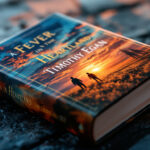Sapiens Volume 3 – The Masters of History by Yuval Noah Harari Review
When history is a competition, who really wins? In Sapiens: A Graphic History, Volume 3 – The Masters of History, Yuval Noah Harari offers a bold take on how human events are shaped. This version isn’t your typical textbook—it’s a lively graphic novel that transforms history into a thought-provoking game show. Featuring characters like Lady Empire and Captain Dollar, it dives into the forces that have guided humanity’s journey, from money to religion. Designed for curious minds and history buffs, this book makes complex ideas easy to grasp, even for those new to nonfiction. If you’re ready to see history in a whole new way, you’re in the right place.
An Overview of ‘The Masters of History’
Yuval Noah Harari’s The Masters of History isn’t just a continuation of his renowned Sapiens series. It’s a clever, entertaining deep-dive that redefines how we view history’s influence on humanity. Told through a graphic format, the book merges critical historical concepts with compelling storytelling, designed to make readers rethink the forces that shape the world today.
The Unique Format: A Game Show of History
Imagine history unfolding in the format of a lively game show. In this graphic novel, allegorical characters debate who truly holds the reins of power. It’s not your typical scholarly setup. Instead, it’s a battle of ideas, where different forces compete for dominance. Harari uses this innovative format to deliver serious topics with a dose of fun.
The game show approach makes learning about history accessible without dumbing down the complexity. It’s like watching your favorite reality competition, but instead of cooking or survival challenges, the contestants spar over empire-building, economics, and religion. This format keeps readers engaged, making abstract concepts tangible and relatable.
Allegorical Figures and Their Roles
What if you could personify history’s greatest influences? In this book, you meet characters like:
- Mr. Random, who represents the unpredictable twists of chance that have changed historical timelines.
- Lady Empire, embodying the rise and fall of imperial dominations from the Roman Empire to British colonization.
- Captain Dollar, a symbol of the role money and capitalism play in steering global economies.
- Skyman, who represents religion and its celestial influence on governance and culture.
These characters bring to life themes we often take for granted. Each figure dramatizes their “claim to fame,” offering insights into how their dominion has shaped human progress.
Expert Panel’s Commentary
What’s a game without judges? Harari introduces an expert panel of commentators to dissect every argument. Featuring a historian, anthropologist, scientist, and even a theologian, these thinkers weigh in with evidence and critique.
It’s like having a running dialogue between creative storytelling and grounded research. The panel not only balances the allegorical debates but also provides deeper context. This adds nuance, giving readers a better understanding of the complexity behind major historical shifts.
Themes Explored in the Book
At its core, The Masters of History explores the key drivers of human civilization. The book touches on:
- Randomness: How chance events like natural disasters and accidents play pivotal roles.
- Empires: From world-conquering dynasties to colonial empires, uncover their lasting impacts.
- Money: Explore the societal transformations brought about by economic systems.
- Religion: Understand how belief systems have united, divided, and inspired humanity.
- Conflicts and Wars: Delve into cycles of aggression and their outcomes.
The blend of these themes creates a multidimensional narrative. It’s not about assigning blame or determining a single “master of history.” Instead, it’s a thought-provoking discussion about how these elements intertwine.
For more about the book, check out this Goodreads review or explore its listing on Barnes & Noble. This fresh take on history is perfect for readers ready to question everything they thought they knew about humanity.
Strengths of the Graphic Novel Format
Graphic novels are more than just books with pictures. They combine art and storytelling to create a unique reading experience that appeals to a wide range of audiences. In Sapiens Volume 3: The Masters of History, this format elevates historical concepts, making them more accessible and engaging. Here’s how.
Engaging Visuals and Storytelling
The illustrations in graphic novels do more than just decorate the page—they bring the story to life. In The Masters of History, vibrant drawings and clever layouts enhance the narrative by adding visual clues to the events being discussed. You don’t just read about historical characters or forces; you see them. The imagery fuels your imagination, making the people and ideas feel more real.
Think about it: how often do we struggle to visualize history while reading traditional books? Graphic novels solve that problem by using imagery to immerse the reader. The expressive characters and dynamic scenes keep your attention locked, similar to watching a visually striking movie that you never want to pause.
Want to dive deeper into the benefits of this approach? Check out 5 Benefits of Reading Graphic Novels from Markham Public Library. It highlights how the format captivates readers in ways traditional texts often fail to achieve.
Simplifying Complex Concepts
History can be overwhelming. Dates, events, theories—it’s easy to get lost in the details. However, graphic novels excel at breaking down heavy topics into bite-sized pieces. In The Masters of History, Yuval Noah Harari uses humor, metaphors, and visual storytelling to make intricate historical ideas manageable.
For example, instead of explaining capitalism solely through dense text, the book creates the character “Captain Dollar.” This visual method simplifies a dense topic like economics into something both relatable and easy to understand. Readers of all ages, especially those new to history, find this approach refreshing and approachable.
Stanford University even highlights how graphic novels help students grasp challenging topics in their article on Graphic Novels Boosting Critical Thinking. The format bridges gaps in understanding, making it a valuable tool for education.
Encouraging Critical Thinking
Unlike textbooks that often focus on presenting facts, graphic novels encourage readers to think for themselves. The Masters of History doesn’t provide all the answers; instead, it raises questions. Who really holds power? How do random events shape history? By presenting different perspectives, the book pushes readers to form their own opinions.
The use of allegorical characters like Lady Empire and Mr. Random illustrates how various forces interact to influence history. Readers are prompted to weigh these ideas critically—like a judge in the book’s own historical “game show.” It’s an engaging way to explore cause-and-effect relationships and question preconceived notions about history.
Balance of Entertainment and Education
A graphic novel like The Masters of History blurs the line between enjoyment and learning. It’s not just an educational tool; it’s fun. The humor, colorful designs, and engaging plots make it easy to forget that you’re actually learning something.
Imagine history class reimagined as a Netflix series—suddenly, it’s hard to look away. The book strikes a perfect balance by delivering essential historical themes while keeping the tone light and playful. This makes it ideal for casual readers who might never pick up a typical history book.
If you’d like to explore more about how graphic novels can entertain while educating, don’t miss Graphic Novels for Building Reading Skills. It’s a reminder of the versatility and appeal of this storytelling medium.
By combining visuals, storytelling, and thought-provoking ideas, Sapiens Volume 3: The Masters of History showcases the true strengths of the graphic novel format. It’s not just storytelling—it’s history told in a way you’ll genuinely want to explore.
Critiques and Limitations
While Sapiens Volume 3: The Masters of History delivers historical insights in a fresh and creative way, it hasn’t escaped criticism. Some readers raise valid points about its approach and execution, which can make or break the reading experience depending on personal preferences.
Potential Distractions in the Format
The book’s game show format, while innovative, isn’t universally loved. A few readers find it a bit too theatrical at times. The extravagant debates and animated “showdowns” between allegorical characters might feel overly contrived, pulling attention away from the historical arguments themselves. It’s like watching a movie with too many special effects—sometimes, the story gets lost in the spectacle.
For those who prefer straightforward storytelling, this format may come across as convoluted or even gimmicky. Library Journal’s review highlights this by pointing out how the “rowdy studio audience” and “commercial breaks” create a lively yet chaotic presentation. While it engages some, others feel the dramatics dilute the book’s educational value.
Lack of Consistency in Characters
One of the book’s unique aspects—its personified historical forces—has also drawn criticism for lacking depth. Some reviewers argue that certain characters behave inconsistently or without clear reasoning. For example, “Captain Dollar,” meant to represent capitalism, often follows a line of thought that feels overly simplified. This occasionally reduces complex systems into caricatures, leaving readers craving more nuanced portrayals.
Readers on Goodreads have noted a disconnect between the actions of these characters and the historical events they represent. They can feel like actors in a play who don’t fully understand their roles, which detracts from the overall storytelling experience.
Preference for Straightforward Narratives
While the dynamic format works for some, others wish the book had stuck to a more traditional delivery of historical arguments. The playful structure might not resonate with readers who are used to the clean, concise flow of Harari’s earlier work, like Sapiens: A Brief History of Humankind. The inclusion of comic-styled art and dramatic sequences can feel overwhelming if you’re simply seeking clear-cut insights on history.
Fans of Harari’s standard writing style have expressed on platforms like Amazon that they’d prefer the author’s sharper, straightforward narrative style. To them, the game-show theme seems at odds with Harari’s usual depth and analysis, which are what drew them to his books in the first place.
Ultimately, the book’s limitations revolve around its adventurous format and creative risks. While these aspects appeal to some, they can alienate readers who favor a more traditional approach to learning about history. Whether you find the style engaging or distracting comes down to personal taste.
Key Lessons from ‘The Masters of History’
Yuval Noah Harari’s The Masters of History takes readers on an intellectual journey through the forces that have shaped human civilization. With its engaging game-show format, this graphic novel challenges traditional perspectives on history and presents key takeaways that are not just academically rich but relevant to real-world understanding. Let’s dive into some of the key lessons the book offers.
The Complexity of Historical Forces
One of the main ideas in The Masters of History is the intricate web of forces driving human history. Harari highlights how empires, economics, and belief systems converge to create what we recognize as “progress”—but it’s not as straightforward as it seems. History isn’t a one-note story; it’s a symphony of overlapping and sometimes clashing influences.
Think of it this way: historical change is like baking a cake. Empires provided the firmness of flour, economics served as the rising agent, and belief systems added the flavor. If any component shifts, the outcome radically changes. Harari vividly portrays this through characters like Lady Empire, who personifies the rise and fall of geopolitical powers, and Captain Dollar, who argues for the unparalleled impact of money on human societies.
By using these characters, Harari explains the power dynamics between systems. For instance, it’s not just the swords of conquerors or the strategies of generals that define historical outcomes. Instead, it’s complex networks of trade, ideological shifts, and even random events that steer the course of civilizations. Want more depth on historical forces? Check out this analysis of the interplay in Harari’s books.
The Importance of Diverse Perspectives
Who writes history? More importantly, whose voices are missing from it? Harari pushes this crucial question to the forefront, emphasizing the value of viewing history from multiple perspectives. Traditional history has often been the story of the “victors,” but what about the stories of the unheard?
Through allegories and arguments, Harari demonstrates that looking at history only from the perspective of empires or dominant cultures leaves enormous gaps in our understanding. Just like you wouldn’t solve a mystery by only hearing one side of the story, history demands voices from all angles—whether it’s those of indigenous groups, women, or the marginalized.
This challenge to the “official” narrative forces readers to critically evaluate what they believe about the past. Taking diverse perspectives into account doesn’t just enlighten us about what has happened but also helps us understand what could happen in the future. Curious about these alternative views? Explore this take on multiple perspectives in history.
Relevance to Modern Readers
What makes The Masters of History resonate even more is its relevance to modern audiences. Harari ties the lessons of the past directly to today’s global challenges. Whether addressing issues like climate change, economic inequality, or digital transformation, the book makes a compelling case: a better understanding of history helps us face the future more intelligently.
For instance, Harari likens the rise of capitalism, represented by Captain Dollar, to the challenges posed by modern tech-driven economies. He shows how historical economic systems laid the groundwork for current technologies, automation, and even our consumer-driven global culture. How does religion, represented by Skyman, still play a role today? Even in our secularized world, belief systems (both old and new) influence policy, culture, and personal identity.
For readers, the takeaway is clear: history isn’t something confined to textbooks. It’s alive in every decision we make, every law we pass, and every technology we develop. Harari’s work is a reminder to not take the status quo for granted and to question how history might unfold moving forward. For broader context, here’s Harari’s insight on connecting history to modern justice.
Each lesson from The Masters of History not only enriches your understanding of the past but also equips you with tools to navigate the complexities of the present and future. It’s a truly transformative read.
Conclusion
The Masters of History by Yuval Noah Harari is a refreshing take on understanding human history, blending rich ideas with an engaging, visual format. By using allegorical characters and a game-show setup, it simplifies complex subjects like economics, religion, and power dynamics into something approachable and thought-provoking.
While some readers may find the theatrics a bit much, the book successfully sparks curiosity and invites readers to question historical narratives. Its vibrant storytelling makes it a great pick for anyone new to history or seeking a creative way to learn.
If you love books that entertain while educating, this one’s worth your time. It’s not just a read—it’s an experience that leaves you asking, “What really shaped the world as we know it?” Go ahead, pick it up, and join the conversation about the forces that continue to influence humanity.







